NISSAN TITAN 2018 Owner´s Manual
Manufacturer: NISSAN, Model Year: 2018, Model line: TITAN, Model: NISSAN TITAN 2018Pages: 650, PDF Size: 7.54 MB
Page 571 of 650

Fluid typeCapacity (approximate) Recommended Fluids/Lubricants
Metric
Measure US
Measure Imperial
Measure
Brake fluid ———• Genuine NISSAN Super Heavy Duty Brake Fluid *2 or equivalent DOT
3.
*2 Available in mainland USA through a NISSAN dealer.
Multi-purpose grease ——— • NLGI No. 2 (Lithium Soap base)
Air conditioning system refrigerant ———• HFC-134a (R-134a)
• For additional information, refer to “Air conditioner system refriger-
ant and oil recommendations” in this section.
Air conditioning system oil ———• Genuine NISSAN A/C System Oil Type S (DH-PS) or equivalent
• For additional information, refer to “Air conditioner system refriger-
ant and oil recommendations” in this section.
Windshield-washer fluid 4.5 L 1-1/4 gal 1 gal• Genuine NISSAN Windshield Washer Concentrate Cleaner & Anti-
freeze fluid or equivalent.
FUEL RECOMMENDATION
Gas engine only
Use unleaded regular gasoline with an oc-
tane rating of at least 87 AKI (Anti-Knock
Index) number (Research octane number
91).
CAUTION
∙ Using a fuel other than that specified
could adversely affect the emission
control system, and may also affect
the warranty coverage. ∙ Under no circumstances should a
leaded gasoline be used, because this
will damage the three-way catalyst.
∙ Do not use E-15 or E-85 fuel in your vehicle. Your vehicle is not designed to
run on E-15 or E-85 fuel. Using E-15 or
E-85 fuel in a vehicle not specifically
designed for E-15 or E-85 fuel can ad-
versely affect the emission control
devices and systems of the vehicle.
Damage caused by such fuel is not
covered by the NISSAN New Vehicle
Limited Warranty. ∙ Do not use fuel that contains the oc-
tane booster methylcyclopentadienyl
manganese tricarbonyl (MMT). Using
fuel containing MMT may adversely
affect vehicle performance and ve-
hicle emissions. Not all fuel dispens-
ers are labeled to indicate MMT con-
tent, so you may have to consult your
gasoline retailer for more details.
Note that Federal and California laws
prohibit the use of MMT in reformu-
lated gasoline.
10-4Technical and consumer information
Page 572 of 650
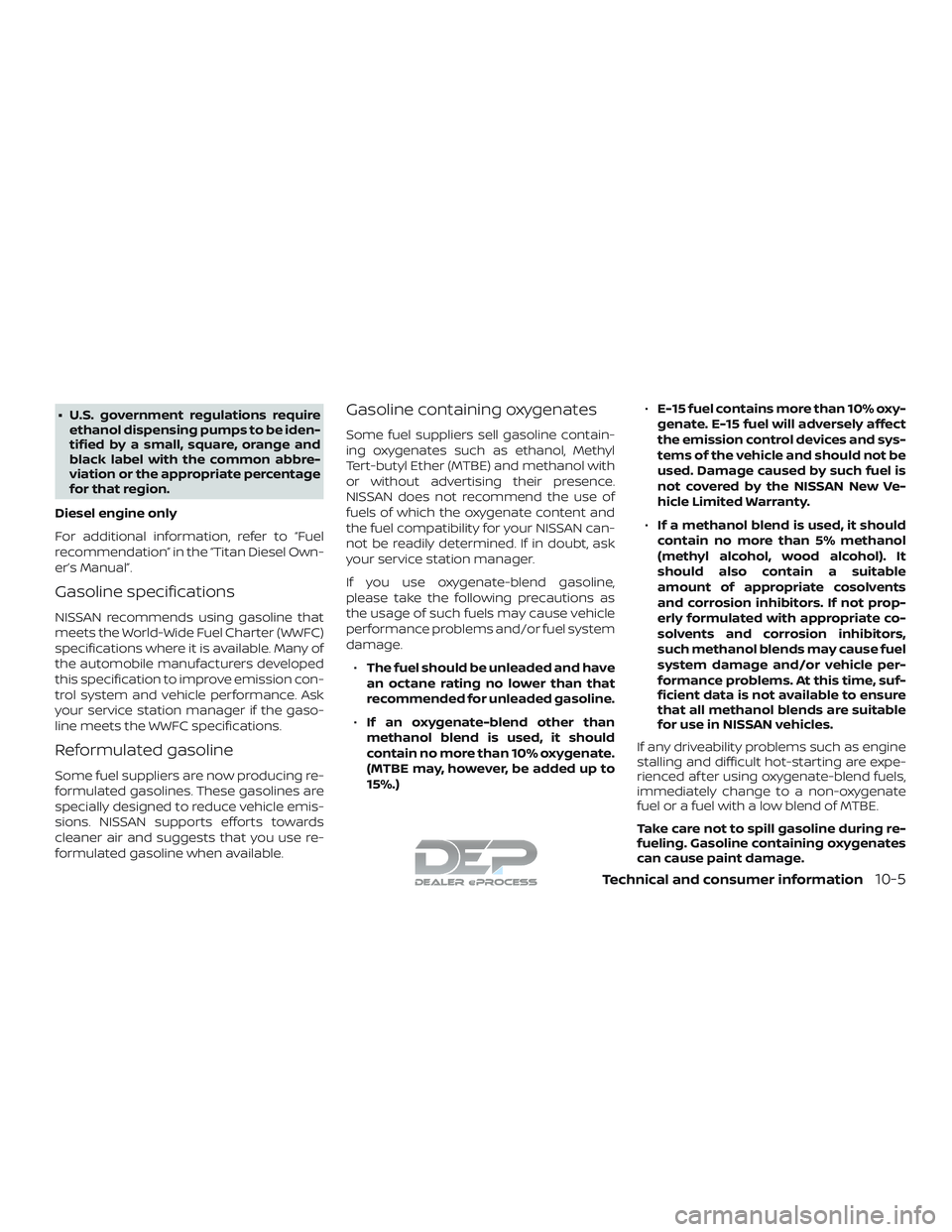
∙ U.S. government regulations requireethanol dispensing pumps to be iden-
tified by a small, square, orange and
black label with the common abbre-
viation or the appropriate percentage
for that region.
Diesel engine only
For additional information, refer to “Fuel
recommendation” in the “Titan Diesel Own-
er’s Manual”.
Gasoline specifications
NISSAN recommends using gasoline that
meets the World-Wide Fuel Charter (WWFC)
specifications where it is available. Many of
the automobile manufacturers developed
this specification to improve emission con-
trol system and vehicle performance. Ask
your service station manager if the gaso-
line meets the WWFC specifications.
Reformulated gasoline
Some fuel suppliers are now producing re-
formulated gasolines. These gasolines are
specially designed to reduce vehicle emis-
sions. NISSAN supports efforts towards
cleaner air and suggests that you use re-
formulated gasoline when available.
Gasoline containing oxygenates
Some fuel suppliers sell gasoline contain-
ing oxygenates such as ethanol, Methyl
Tert-butyl Ether (MTBE) and methanol with
or without advertising their presence.
NISSAN does not recommend the use of
fuels of which the oxygenate content and
the fuel compatibility for your NISSAN can-
not be readily determined. If in doubt, ask
your service station manager.
If you use oxygenate-blend gasoline,
please take the following precautions as
the usage of such fuels may cause vehicle
performance problems and/or fuel system
damage. ∙ The fuel should be unleaded and have
an octane rating no lower than that
recommended for unleaded gasoline.
∙ If an oxygenate-blend other than
methanol blend is used, it should
contain no more than 10% oxygenate.
(MTBE may, however, be added up to
15%.) ∙
E-15 fuel contains more than 10% oxy-
genate. E-15 fuel will adversely affect
the emission control devices and sys-
tems of the vehicle and should not be
used. Damage caused by such fuel is
not covered by the NISSAN New Ve-
hicle Limited Warranty.
∙ If a methanol blend is used, it should
contain no more than 5% methanol
(methyl alcohol, wood alcohol). It
should also contain a suitable
amount of appropriate cosolvents
and corrosion inhibitors. If not prop-
erly formulated with appropriate co-
solvents and corrosion inhibitors,
such methanol blends may cause fuel
system damage and/or vehicle per-
formance problems. At this time, suf-
ficient data is not available to ensure
that all methanol blends are suitable
for use in NISSAN vehicles.
If any driveability problems such as engine
stalling and difficult hot-starting are expe-
rienced af ter using oxygenate-blend fuels,
immediately change to a non-oxygenate
fuel or a fuel with a low blend of MTBE.
Take care not to spill gasoline during re-
fueling. Gasoline containing oxygenates
can cause paint damage.
Technical and consumer information10-5
Page 573 of 650
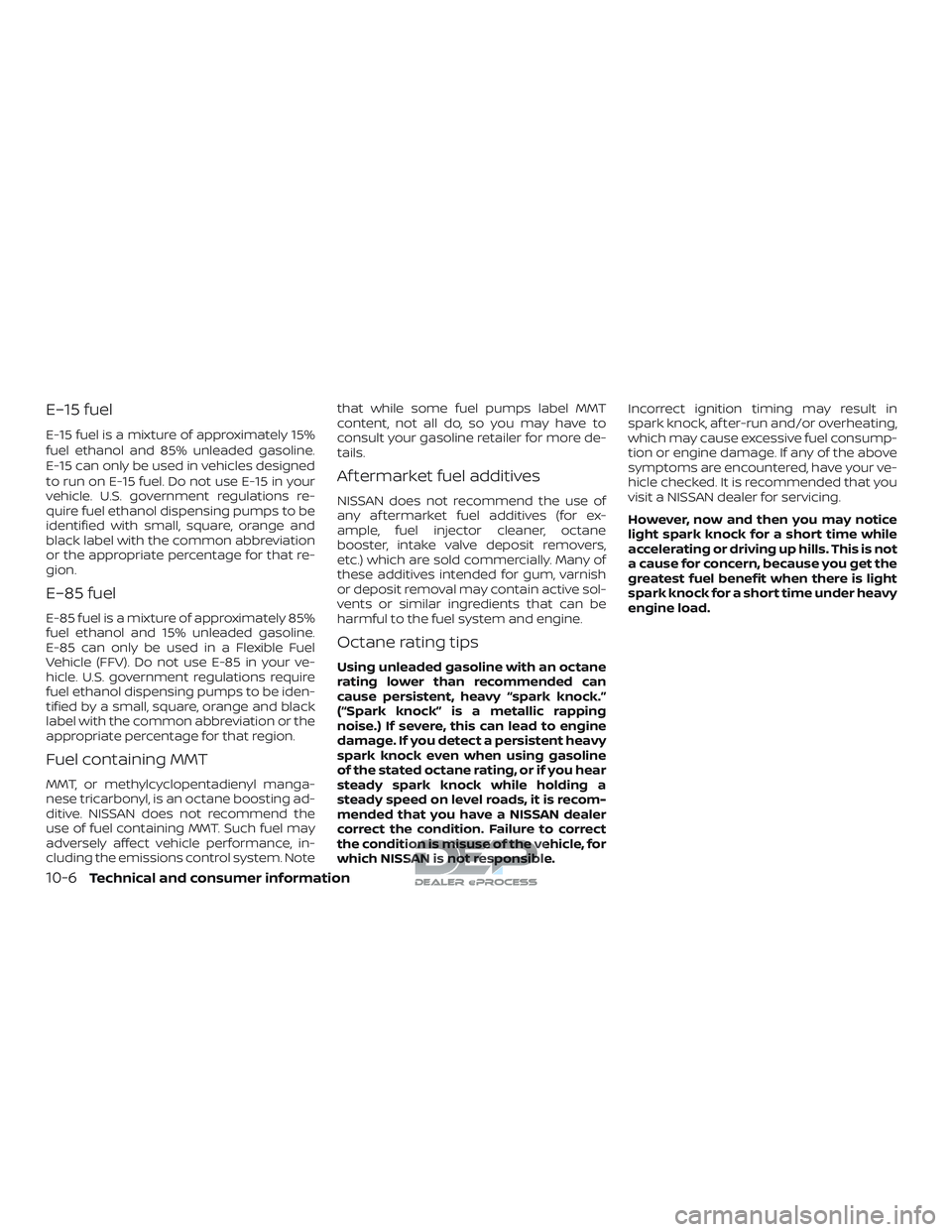
E–15 fuel
E-15 fuel is a mixture of approximately 15%
fuel ethanol and 85% unleaded gasoline.
E-15 can only be used in vehicles designed
to run on E-15 fuel. Do not use E-15 in your
vehicle. U.S. government regulations re-
quire fuel ethanol dispensing pumps to be
identified with small, square, orange and
black label with the common abbreviation
or the appropriate percentage for that re-
gion.
E–85 fuel
E-85 fuel is a mixture of approximately 85%
fuel ethanol and 15% unleaded gasoline.
E-85 can only be used in a Flexible Fuel
Vehicle (FFV). Do not use E-85 in your ve-
hicle. U.S. government regulations require
fuel ethanol dispensing pumps to be iden-
tified by a small, square, orange and black
label with the common abbreviation or the
appropriate percentage for that region.
Fuel containing MMT
MMT, or methylcyclopentadienyl manga-
nese tricarbonyl, is an octane boosting ad-
ditive. NISSAN does not recommend the
use of fuel containing MMT. Such fuel may
adversely affect vehicle performance, in-
cluding the emissions control system. Notethat while some fuel pumps label MMT
content, not all do, so you may have to
consult your gasoline retailer for more de-
tails.
Af termarket fuel additives
NISSAN does not recommend the use of
any af termarket fuel additives (for ex-
ample, fuel injector cleaner, octane
booster, intake valve deposit removers,
etc.) which are sold commercially. Many of
these additives intended for gum, varnish
or deposit removal may contain active sol-
vents or similar ingredients that can be
harmful to the fuel system and engine.
Octane rating tips
Using unleaded gasoline with an octane
rating lower than recommended can
cause persistent, heavy “spark knock.”
(“Spark knock” is a metallic rapping
noise.) If severe, this can lead to engine
damage. If you detect a persistent heavy
spark knock even when using gasoline
of the stated octane rating, or if you hear
steady spark knock while holding a
steady speed on level roads, it is recom-
mended that you have a NISSAN dealer
correct the condition. Failure to correct
the condition is misuse of the vehicle, for
which NISSAN is not responsible.Incorrect ignition timing may result in
spark knock, af ter-run and/or overheating,
which may cause excessive fuel consump-
tion or engine damage. If any of the above
symptoms are encountered, have your ve-
hicle checked. It is recommended that you
visit a NISSAN dealer for servicing.
However, now and then you may notice
light spark knock for a short time while
accelerating or driving up hills. This is not
a cause for concern, because you get the
greatest fuel benefit when there is light
spark knock for a short time under heavy
engine load.
10-6Technical and consumer information
Page 574 of 650
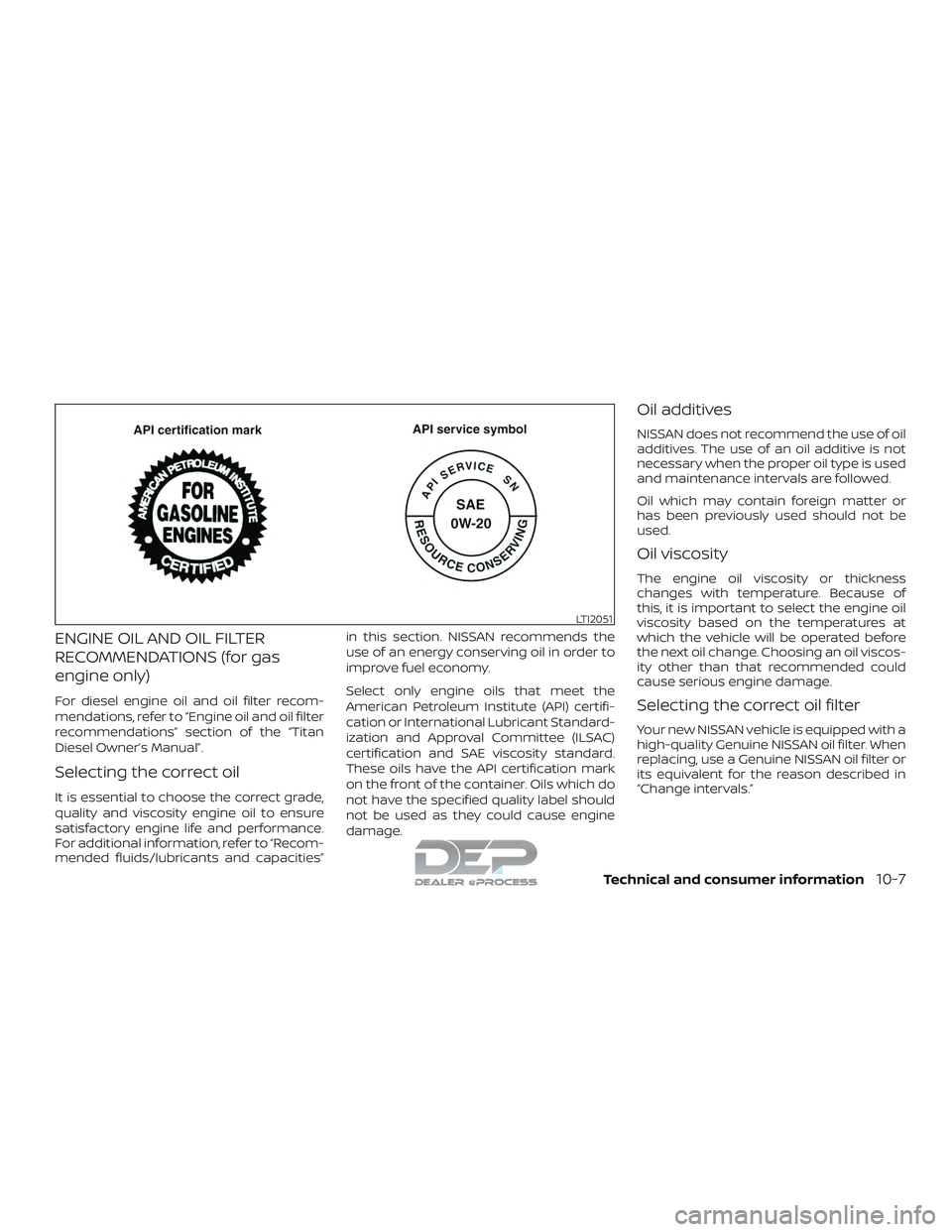
ENGINE OIL AND OIL FILTER
RECOMMENDATIONS (for gas
engine only)
For diesel engine oil and oil filter recom-
mendations, refer to “Engine oil and oil filter
recommendations” section of the “Titan
Diesel Owner’s Manual”.
Selecting the correct oil
It is essential to choose the correct grade,
quality and viscosity engine oil to ensure
satisfactory engine life and performance.
For additional information, refer to “Recom-
mended fluids/lubricants and capacities”in this section. NISSAN recommends the
use of an energy conserving oil in order to
improve fuel economy.
Select only engine oils that meet the
American Petroleum Institute (API) certifi-
cation or International Lubricant Standard-
ization and Approval Committee (ILSAC)
certification and SAE viscosity standard.
These oils have the API certification mark
on the front of the container. Oils which do
not have the specified quality label should
not be used as they could cause engine
damage.
Oil additives
NISSAN does not recommend the use of oil
additives. The use of an oil additive is not
necessary when the proper oil type is used
and maintenance intervals are followed.
Oil which may contain foreign matter or
has been previously used should not be
used.
Oil viscosity
The engine oil viscosity or thickness
changes with temperature. Because of
this, it is important to select the engine oil
viscosity based on the temperatures at
which the vehicle will be operated before
the next oil change. Choosing an oil viscos-
ity other than that recommended could
cause serious engine damage.
Selecting the correct oil filter
Your new NISSAN vehicle is equipped with a
high-quality Genuine NISSAN oil filter. When
replacing, use a Genuine NISSAN oil filter or
its equivalent for the reason described in
“Change intervals.”
LTI2051
Technical and consumer information10-7
Page 575 of 650
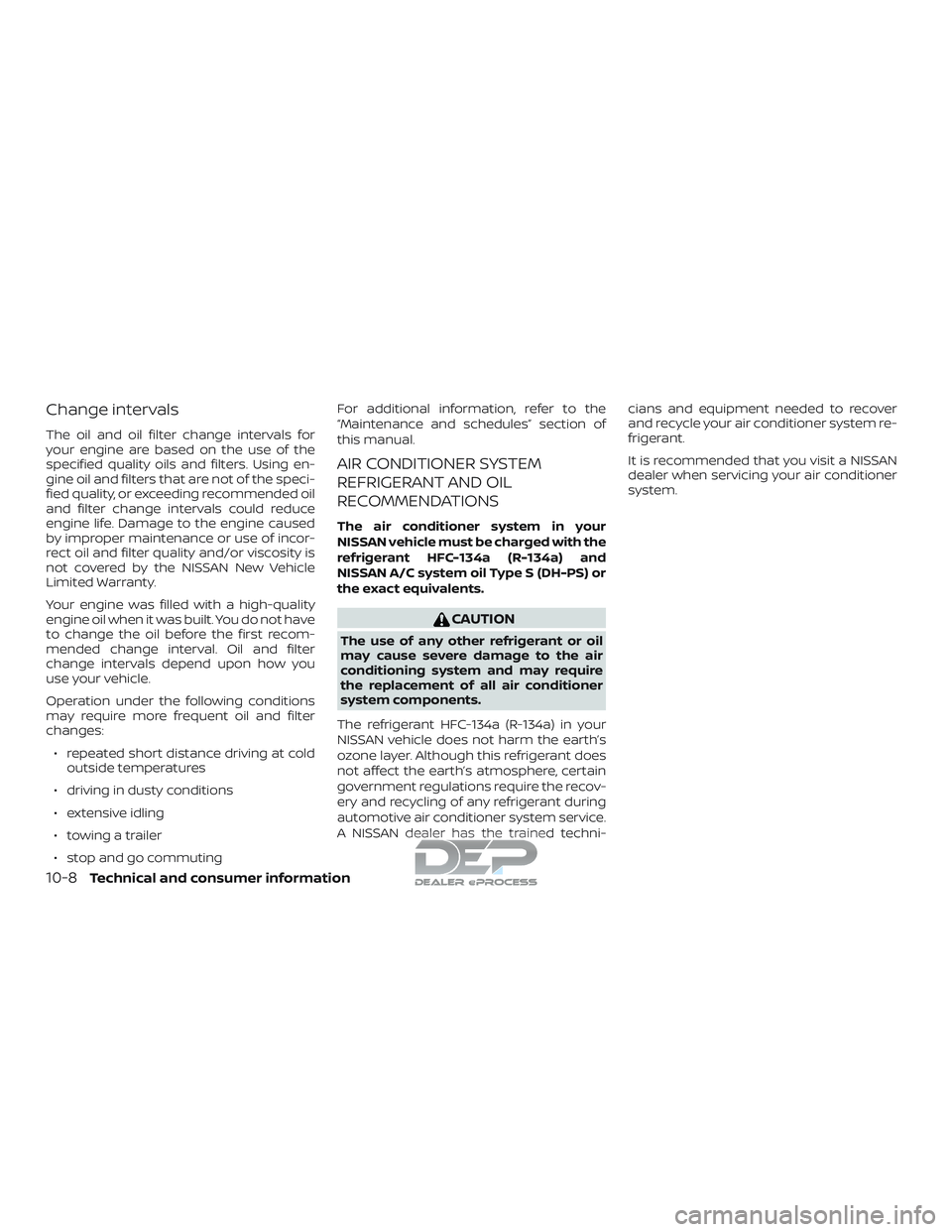
Change intervals
The oil and oil filter change intervals for
your engine are based on the use of the
specified quality oils and filters. Using en-
gine oil and filters that are not of the speci-
fied quality, or exceeding recommended oil
and filter change intervals could reduce
engine life. Damage to the engine caused
by improper maintenance or use of incor-
rect oil and filter quality and/or viscosity is
not covered by the NISSAN New Vehicle
Limited Warranty.
Your engine was filled with a high-quality
engine oil when it was built. You do not have
to change the oil before the first recom-
mended change interval. Oil and filter
change intervals depend upon how you
use your vehicle.
Operation under the following conditions
may require more frequent oil and filter
changes:∙ repeated short distance driving at cold outside temperatures
∙ driving in dusty conditions
∙ extensive idling
∙ towing a trailer
∙ stop and go commuting For additional information, refer to the
“Maintenance and schedules” section of
this manual.
AIR CONDITIONER SYSTEM
REFRIGERANT AND OIL
RECOMMENDATIONS
The air conditioner system in your
NISSAN vehicle must be charged with the
refrigerant HFC-134a (R-134a) and
NISSAN A/C system oil Type S (DH-PS) or
the exact equivalents.
CAUTION
The use of any other refrigerant or oil
may cause severe damage to the air
conditioning system and may require
the replacement of all air conditioner
system components.
The refrigerant HFC-134a (R-134a) in your
NISSAN vehicle does not harm the earth’s
ozone layer. Although this refrigerant does
not affect the earth’s atmosphere, certain
government regulations require the recov-
ery and recycling of any refrigerant during
automotive air conditioner system service.
A NISSAN dealer has the trained techni- cians and equipment needed to recover
and recycle your air conditioner system re-
frigerant.
It is recommended that you visit a NISSAN
dealer when servicing your air conditioner
system.
10-8Technical and consumer information
Page 576 of 650
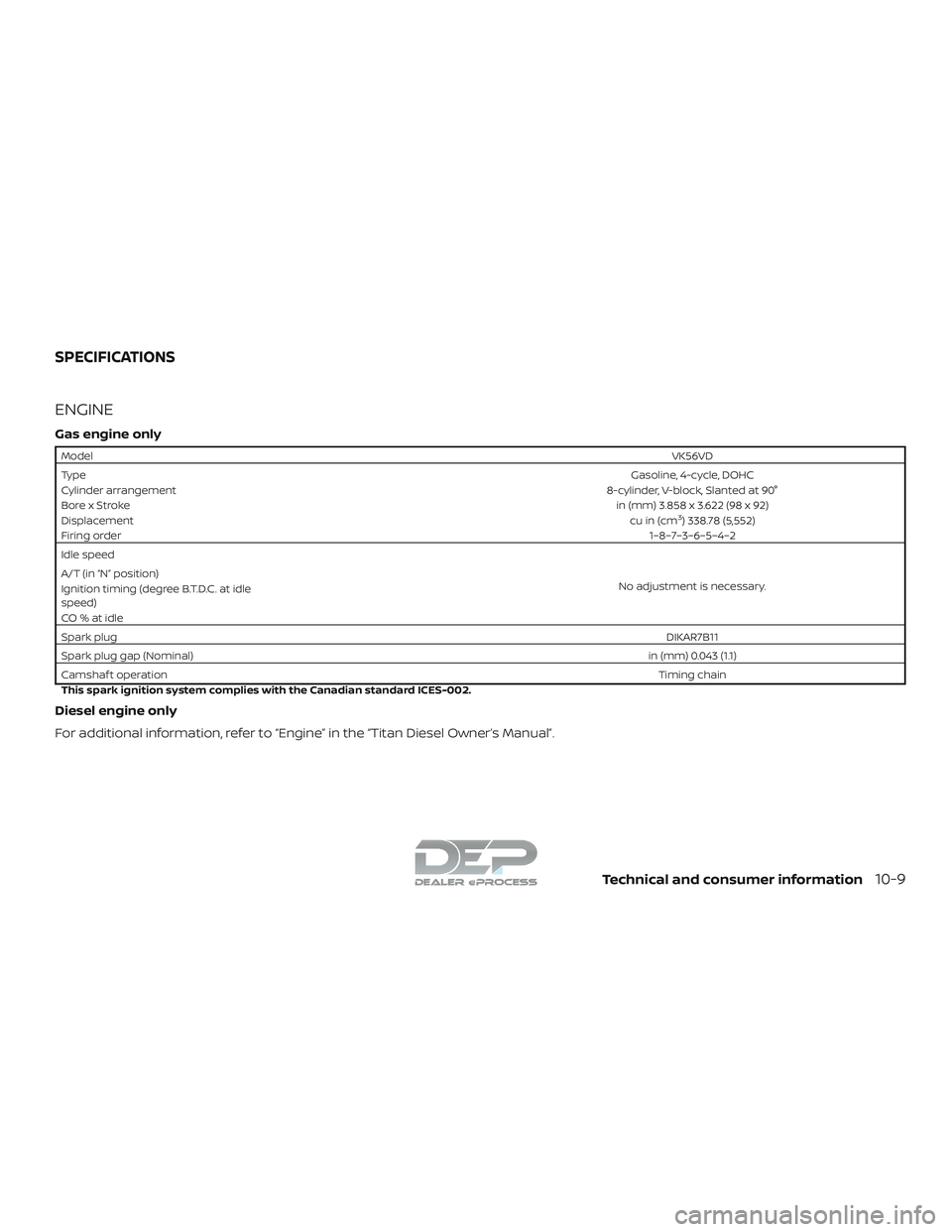
ENGINE
Gas engine only
ModelVK56VD
Type Gasoline, 4-cycle, DOHC
Cylinder arrangement 8-cylinder, V-block, Slanted at 90°
Bore x Stroke in (mm) 3.858 x 3.622 (98 x 92)
Displacement cu in (cm
3) 338.78 (5,552)
Firing order 1–8–7–3–6–5–4–2
Idle speed
No adjustment is necessary.
A/T (in “N” position)
Ignition timing (degree B.T.D.C. at idle
speed)
CO%atidle
Spark plug
DIKAR7B11
Spark plug gap (Nominal) in (mm) 0.043 (1.1)
Camshaf t operation Timing chain
This spark ignition system complies with the Canadian standard ICES-002.
Diesel engine only
For additional information, refer to “Engine” in the “Titan Diesel Owner’s Manual”.
SPECIFICATIONS
Technical and consumer information10-9
Page 577 of 650
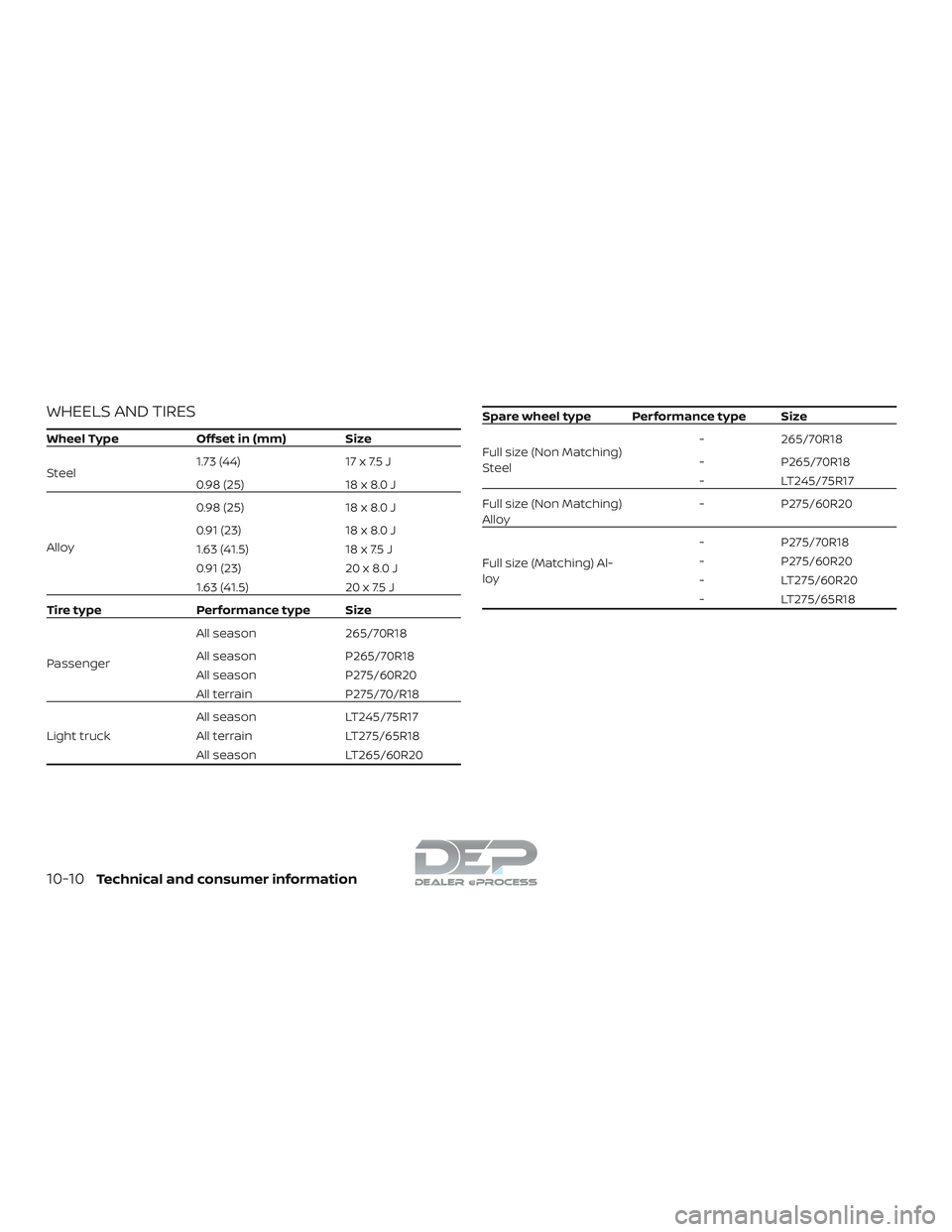
WHEELS AND TIRES
Wheel TypeOffset in (mm) Size
Steel 1.73 (44)
17 x 7.5 J
0.98 (25) 18 x 8.0 J
Alloy 0.98 (25)
18 x 8.0 J
0.91 (23) 18 x 8.0 J
1.63 (41.5) 18 x 7.5 J
0.91(23) 20x8.0J
1.63 (41.5) 20 x 7.5 J
Tire type Performance type Size
Passenger All season
265/70R18
All season P265/70R18
All season P275/60R20
All terrain P275/70/R18
Light truck All season
LT245/75R17
All terrain LT275/65R18
All season LT265/60R20
Spare wheel type Performance type Size
Full size (Non Matching)
Steel -
265/70R18
- P265/70R18
- LT245/75R17
Full size (Non Matching)
Alloy -
P275/60R20
Full size (Matching) Al-
loy -
P275/70R18
- P275/60R20
- LT275/60R20
- LT275/65R18
10-10Technical and consumer information
Page 578 of 650
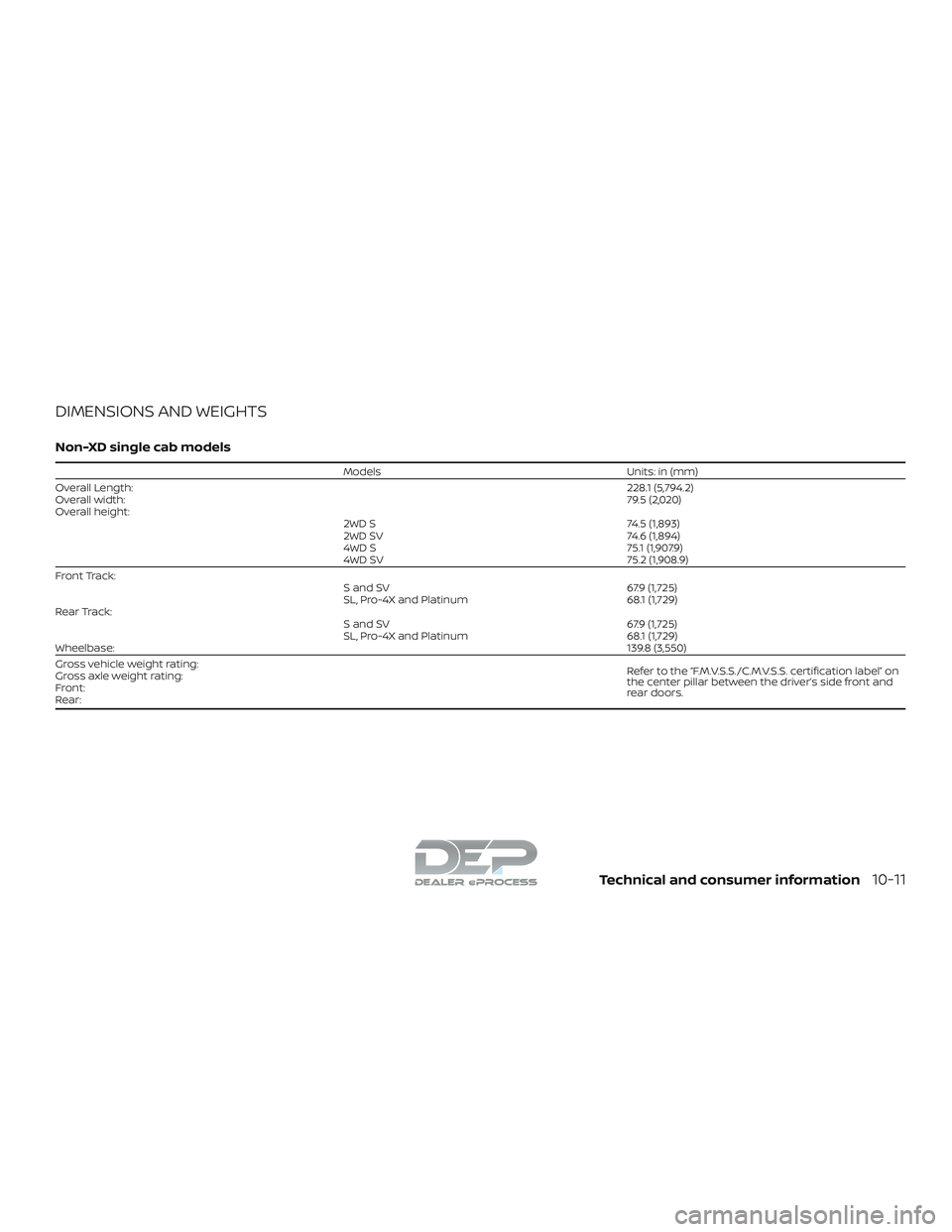
DIMENSIONS AND WEIGHTS
Non-XD single cab models
ModelsUnits: in (mm)
Overall Length: 228.1 (5,794.2)
Overall width: 79.5 (2,020)
Overall height: 2WD S74.5 (1,893)
2WD SV 74.6 (1,894)
4WD S 75.1 (1,907.9)
4WD SV 75.2 (1,908.9)
Front Track: S and SV67.9 (1,725)
SL, Pro-4X and Platinum 68.1 (1,729)
Rear Track: S and SV67.9 (1,725)
SL, Pro-4X and Platinum 68.1 (1,729)
Wheelbase: 139.8 (3,550)
Gross vehicle weight rating: Refer to the “F.M.V.S.S./C.M.V.S.S. certification label” on
the center pillar between the driver’s side front and
rear doors.
Gross axle weight rating:
Front:
Rear:
Technical and consumer information10-11
Page 579 of 650
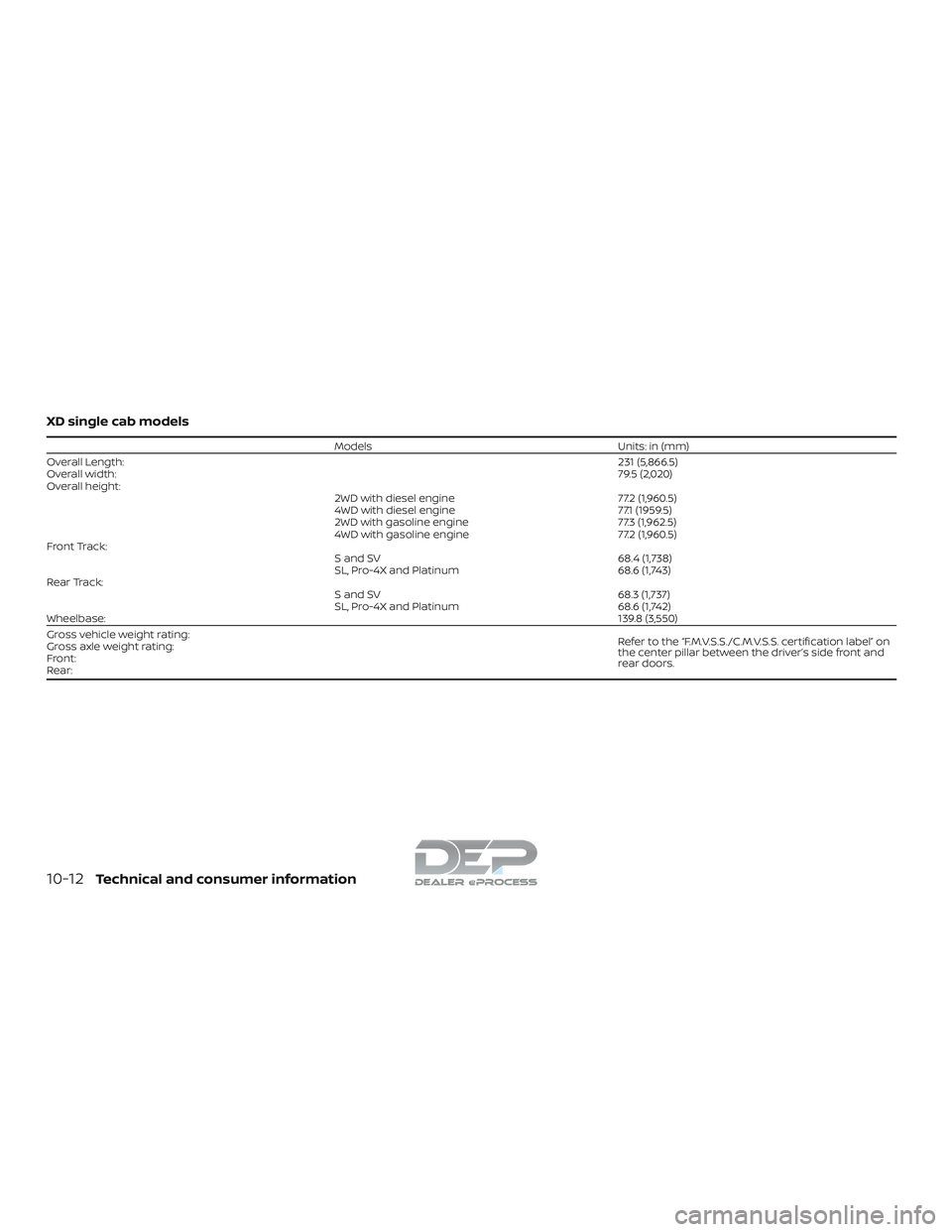
XD single cab models
ModelsUnits: in (mm)
Overall Length: 231 (5,866.5)
Overall width: 79.5 (2,020)
Overall height: 2WD with diesel engine77.2 (1,960.5)
4WD with diesel engine 77.1 (1959.5)
2WD with gasoline engine 77.3 (1,962.5)
4WD with gasoline engine 77.2 (1,960.5)
Front Track: S and SV68.4 (1,738)
SL, Pro-4X and Platinum 68.6 (1,743)
Rear Track: S and SV68.3 (1,737)
SL, Pro-4X and Platinum 68.6 (1,742)
Wheelbase: 139.8 (3,550)
Gross vehicle weight rating: Refer to the “F.M.V.S.S./C.M.V.S.S. certification label” on
the center pillar between the driver’s side front and
rear doors.
Gross axle weight rating:
Front:
Rear:
10-12Technical and consumer information
Page 580 of 650
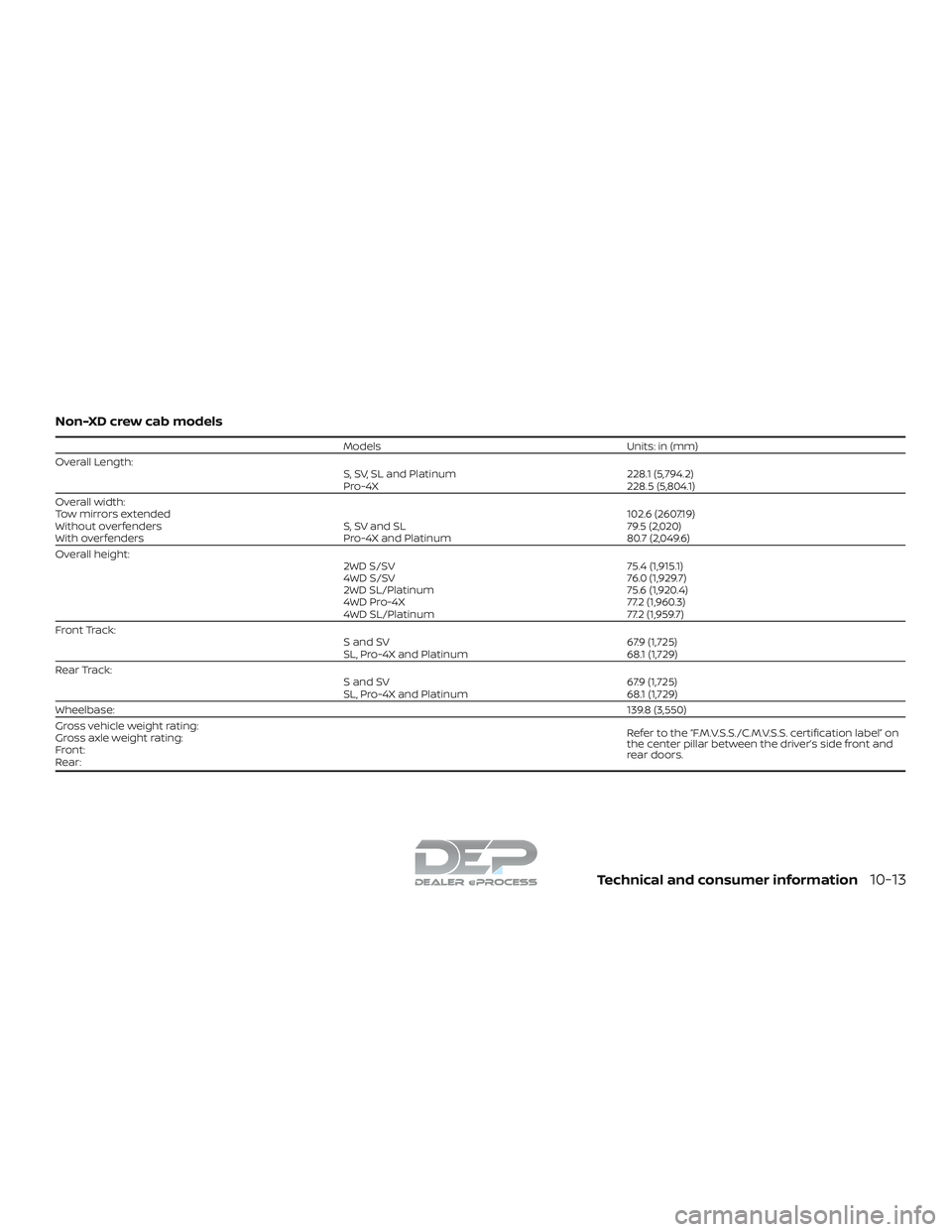
Non-XD crew cab models
ModelsUnits: in (mm)
Overall Length: S, SV, SL and Platinum228.1 (5,794.2)
Pro-4X 228.5 (5,804.1)
Overall width:
Tow mirrors extended 102.6 (2607.19)
Without overfenders S, SV and SL79.5 (2,020)
With overfenders Pro-4X and Platinum80.7 (2,049.6)
Overall height: 2WD S/SV75.4 (1,915.1)
4WD S/SV 76.0 (1,929.7)
2WD SL/Platinum 75.6 (1,920.4)
4WD Pro-4X 77.2 (1,960.3)
4WD SL/Platinum 77.2 (1,959.7)
Front Track: S and SV67.9 (1,725)
SL, Pro-4X and Platinum 68.1 (1,729)
Rear Track: S and SV67.9 (1,725)
SL, Pro-4X and Platinum 68.1 (1,729)
Wheelbase: 139.8 (3,550)
Gross vehicle weight rating: Refer to the “F.M.V.S.S./C.M.V.S.S. certification label” on
the center pillar between the driver’s side front and
rear doors.
Gross axle weight rating:
Front:
Rear:
Technical and consumer information10-13